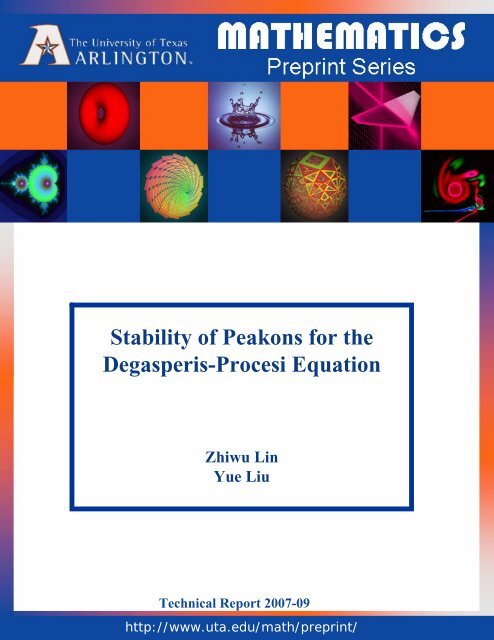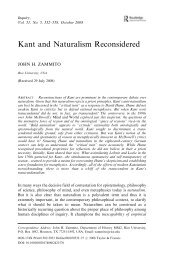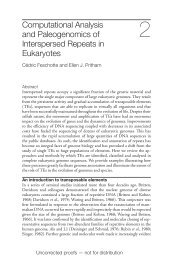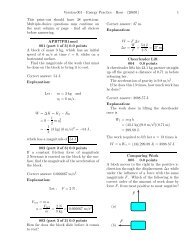Stability of Peakons for the Degasperis-Procesi Equation
Stability of Peakons for the Degasperis-Procesi Equation
Stability of Peakons for the Degasperis-Procesi Equation
Create successful ePaper yourself
Turn your PDF publications into a flip-book with our unique Google optimized e-Paper software.
<strong>Stability</strong> <strong>of</strong> <strong>Peakons</strong> <strong>for</strong> <strong>the</strong><br />
<strong>Degasperis</strong>-<strong>Procesi</strong> <strong>Equation</strong><br />
Zhiwu Lin<br />
Yue Liu<br />
Technical Report 2007-09<br />
http://www.uta.edu/math/preprint/
<strong>Stability</strong> <strong>of</strong> peakons <strong>for</strong> <strong>the</strong><br />
<strong>Degasperis</strong>-<strong>Procesi</strong> equation<br />
Zhiwu Lin ∗ and Yue Liu †<br />
Abstract<br />
The <strong>Degasperis</strong>-<strong>Procesi</strong> equation can be derived as a member <strong>of</strong> a oneparameter<br />
family <strong>of</strong> asymptotic shallow water approximations to <strong>the</strong> Euler<br />
equations with <strong>the</strong> same asymptotic accuracy as that <strong>of</strong> <strong>the</strong> Camassa-<br />
Holm equation. It is noted that <strong>the</strong> <strong>Degasperis</strong>-<strong>Procesi</strong> equation, unlike<br />
<strong>the</strong> Camassa-Holm equation, has not only peakon solitons but also shock<br />
peakons. In this paper, we study <strong>the</strong> orbital stability problem <strong>of</strong> <strong>the</strong><br />
peaked solitons to <strong>the</strong> <strong>Degasperis</strong>-<strong>Procesi</strong> equation on <strong>the</strong> line. By constructing<br />
a Liapunov function, we prove that <strong>the</strong> shapes <strong>of</strong> <strong>the</strong>se peakon<br />
solitons are stable under small perturbations.<br />
Keywords:<br />
Stabiltiy; <strong>Degasperis</strong>-<strong>Procesi</strong> equation; <strong>Peakons</strong><br />
Ma<strong>the</strong>matics Subject Classification (2000): 35G35, 35Q51, 35G25, 35L05<br />
1 Introduction<br />
The <strong>Degasperis</strong>-<strong>Procesi</strong> (DP) equation<br />
y t + y x u + 3yu x = 0, x ∈ R, t > 0, (1.1)<br />
with y = u − u xx , was originally derived by <strong>Degasperis</strong>-<strong>Procesi</strong> [13] using <strong>the</strong><br />
method <strong>of</strong> asymptotic integrability up to third order as one <strong>of</strong> three equations<br />
in <strong>the</strong> family <strong>of</strong> third order dispersive PDE conservation laws <strong>of</strong> <strong>the</strong> <strong>for</strong>m<br />
u t − α 2 u xxt + γu xxx + c 0 u x = (c 1 u 2 + c 2 u 2 x + c 3 uu xx ) x . (1.2)<br />
The o<strong>the</strong>r two integrable equations in <strong>the</strong> family, after rescaling and applying a<br />
Galilean trans<strong>for</strong>mation, are <strong>the</strong> Korteweg-de Vries (KdV) equation<br />
u t + u xxx + uu x = 0<br />
and <strong>the</strong> Camassa-Holm (CH) shallow water equation [2, 14, 17, 21],<br />
y t + y x u + 2yu x = 0, y = u − u xx . (1.3)<br />
∗ Department <strong>of</strong> Ma<strong>the</strong>matics, University <strong>of</strong> Missouri, Columbia, MO 65211,<br />
lin@math.missouri.edu<br />
† Department <strong>of</strong> Ma<strong>the</strong>matics, University <strong>of</strong> Texas, Arlington, TX 76019, yliu@uta.edu<br />
1
These three cases exhaust in <strong>the</strong> completely integrable candidates <strong>for</strong> (1.2) by<br />
Painlevé analysis. <strong>Degasperis</strong>, Holm and Hone [12] showed <strong>the</strong> <strong>for</strong>mal integrability<br />
<strong>of</strong> <strong>the</strong> DP equation as Hamiltonian systems by constructing a Lax pair<br />
and a bi-Hamiltonian structure.<br />
The Camassa-Holm equation was first derived by Fokas and Fuchassteiner<br />
[17] as a bi-Hamiltonian system, and <strong>the</strong>n as a model <strong>for</strong> shallow water waves<br />
by Camassa and Holm [2]. The DP equation is also in dimensionless spacetime<br />
variables (x, t) an approximation to <strong>the</strong> incompressible Euler equations<br />
<strong>for</strong> shallow water under <strong>the</strong> Kodama trans<strong>for</strong>mation [19, 20] and its asymptotic<br />
accuracy is <strong>the</strong> same as that <strong>of</strong> <strong>the</strong> Camassa-Holm (CH) shallow water equation,<br />
where u(t, x) is considered as <strong>the</strong> fluid velocity at time t in <strong>the</strong> spatial x-direction<br />
with momentum density y.<br />
Recently, Liu and Yin [23] proved that <strong>the</strong> first blow-up in finite time to<br />
equation (1.1) must occur as wave breaking and shock waves possibly appear<br />
afterwards. It is shown in [23] that <strong>the</strong> lifespan <strong>of</strong> solutions <strong>of</strong> <strong>the</strong> DP equation<br />
(1.1) is not affected by <strong>the</strong> smoothness and size <strong>of</strong> <strong>the</strong> initial pr<strong>of</strong>iles, but affected<br />
by <strong>the</strong> shape <strong>of</strong> <strong>the</strong> initial pr<strong>of</strong>iles. This can be viewed as a significant difference<br />
between <strong>the</strong> DP equation (or <strong>the</strong> CH equation ) and <strong>the</strong> KdV. It is also noted<br />
that <strong>the</strong> KdV equation, unlike <strong>the</strong> CH equation or DP equation, does not have<br />
wave breaking phenomena, that is, wave remains bounded, but its slope becomes<br />
unbounded in finite time [28].<br />
It is well known that <strong>the</strong> KdV equation is an integrable Hamiltonian equation<br />
that possesses smooth solitons as traveling waves. In <strong>the</strong> KdV equation, <strong>the</strong><br />
leading order asymptotic balance that confines <strong>the</strong> traveling wave solitons occurs<br />
between nonlinear steepening and linear dispersion. However, <strong>the</strong> nonlinear<br />
dispersion and nonlocal balance in <strong>the</strong> CH equation and <strong>the</strong> DP equation, even<br />
in <strong>the</strong> absence <strong>of</strong> linear dispersion, can still produce a confined solitary traveling<br />
waves<br />
u(t, x) = cϕ(x − ct) (1.4)<br />
traveling at constant speed c > 0, where ϕ(x) = e −|x| . Because <strong>of</strong> <strong>the</strong>ir shape<br />
(<strong>the</strong>y are smooth except <strong>for</strong> a peak at <strong>the</strong>ir crest), <strong>the</strong>se solutions are called <strong>the</strong><br />
peakons [2, 12]. <strong>Peakons</strong> <strong>of</strong> both equations are true solitons that interact via<br />
elastic collisions under <strong>the</strong> CH dynamics, or <strong>the</strong> DP dynamics, respectively. The<br />
peakons <strong>of</strong> <strong>the</strong> CH equation are orbitally stable [11]. For waves that approximate<br />
<strong>the</strong> peakons in a special way, a stability result was proved by a variation method<br />
[10].<br />
Note that we can rewrite <strong>the</strong> DP equation as<br />
u t − u txx + 4uu x = 3u x u xx + uu xxx , t > 0, x ∈ R. (1.5)<br />
The peaked solitons are not classical solutions <strong>of</strong> (1.5).<br />
<strong>Degasperis</strong>-<strong>Procesi</strong> equation in <strong>the</strong> conservation law <strong>for</strong>m<br />
They satisfy <strong>the</strong><br />
u t + ∂ x<br />
( 1<br />
2 u2 + 1 2 ϕ ∗ ( 3<br />
2 u2 ))<br />
= 0, t > 0, x ∈ R, (1.6)<br />
2
where ∗ stands <strong>for</strong> convolution with respect to <strong>the</strong> spatial variable x ∈ R. This<br />
is <strong>the</strong> exact meaning in which <strong>the</strong> peakons are solutions.<br />
Recently, Lundmark and Szmigielski [25] presented an inverse scattering<br />
approach <strong>for</strong> computing n-peakon solutions to equation (1.5). Holm and Staley<br />
[19] studied stability <strong>of</strong> solitons and peakons numerically to equation (1.5).<br />
Analogous to <strong>the</strong> case <strong>of</strong> Camassa-Holm equation [6], Henry [18] showed that<br />
smooth solutions to equation (1.5) have infinite speed <strong>of</strong> propagation.<br />
The following are three useful conservation laws <strong>of</strong> <strong>the</strong> <strong>Degasperis</strong>-<strong>Procesi</strong><br />
equation.<br />
∫<br />
∫<br />
∫<br />
E 1 (u) = y dx, E 2 (u) = yv dx, E 3 (u) = u 3 dx,<br />
R<br />
where y = (1 − ∂x)u 2 and v = (4 − ∂x) 2 −1 u, while <strong>the</strong> corresponding three useful<br />
conservation laws <strong>of</strong> <strong>the</strong> Camassa-Holm equation are <strong>the</strong> following:<br />
∫<br />
∫<br />
∫<br />
F 1 (u) = y dx, F 2 (u) = (u 2 + u 2 x) dx, F 3 (u) = (u 3 + uu 2 x) dx. (1.7)<br />
R<br />
R<br />
The stability <strong>of</strong> solitary waves is one <strong>of</strong> <strong>the</strong> fundamental qualitative properties<br />
<strong>of</strong> <strong>the</strong> solutions <strong>of</strong> nonlinear wave equations. Numerical simulations [12, 24]<br />
suggest that <strong>the</strong> sizes and velocities <strong>of</strong> <strong>the</strong> peakons do not change as a result <strong>of</strong><br />
collision so <strong>the</strong>se patterns are expected to be stable. Fur<strong>the</strong>rmore, it is observed<br />
that <strong>the</strong> shape <strong>of</strong> <strong>the</strong> peakons remains approximately <strong>the</strong> same as time evolves.<br />
As far as we know, <strong>the</strong> case <strong>of</strong> stability <strong>of</strong> <strong>the</strong> peakons <strong>for</strong> <strong>the</strong> Camassa-Holm<br />
equation is well understood by now [10, 11], while <strong>the</strong> <strong>Degasperis</strong>-<strong>Procesi</strong> equation<br />
case is <strong>the</strong> subject <strong>of</strong> this paper. The goal <strong>of</strong> this paper is to establish a<br />
stability result <strong>of</strong> peaked solitons <strong>for</strong> equation (1.5).<br />
It is found that <strong>the</strong> corresponding conservation laws <strong>of</strong> <strong>the</strong> <strong>Degasperis</strong>-<br />
<strong>Procesi</strong> equation are much weaker than those <strong>of</strong> <strong>the</strong> Camassa-Holm equation.<br />
In particular, one can see that <strong>the</strong> conservation law E 2 (u) <strong>for</strong> <strong>the</strong> DP equation<br />
is equivalent to ‖u‖ 2 L 2 . In fact, by <strong>the</strong> Fourier trans<strong>for</strong>m, we have<br />
∫<br />
E 2 (u) =<br />
R<br />
∫<br />
yvdx =<br />
R<br />
R<br />
R<br />
1 + ξ 2<br />
4 + ξ 2 |û(ξ)|2 dξ ∼ ‖û‖ 2 L = 2 ‖u‖2 L2. (1.8)<br />
There<strong>for</strong>e, <strong>the</strong> stability issue <strong>of</strong> <strong>the</strong> peaked solitons <strong>of</strong> <strong>the</strong> DP equation is more<br />
subtle .<br />
For <strong>the</strong> DP equation, we can only expect to obtain <strong>the</strong> orbital stability <strong>of</strong><br />
peakons in <strong>the</strong> sense <strong>of</strong> L 2 −norm due to a weaker conservation law E 2 . The<br />
solutions <strong>of</strong> <strong>the</strong> DP equation usually tend to be oscillations which spread out<br />
spatially in a quite complicated way. In general, a small perturbation <strong>of</strong> a<br />
solitary wave can yield ano<strong>the</strong>r one with a different speed and phase shift. We<br />
define <strong>the</strong> orbit <strong>of</strong> traveling-wave solutions cϕ to be <strong>the</strong> set U(ϕ) = {cϕ(· +<br />
x 0 ), x 0 ∈ R}, and a peaked soliton <strong>of</strong> <strong>the</strong> DP equation is called orbitally stable<br />
if a wave starting close to <strong>the</strong> peakon remains close to some translate <strong>of</strong> it at<br />
all later times.<br />
R<br />
3
Let us denote<br />
E 2 (u) = ‖u‖ 2 X.<br />
The following stability <strong>the</strong>orem is <strong>the</strong> principal result <strong>of</strong> <strong>the</strong> present paper.<br />
Theorem 1 (<strong>Stability</strong>) Let cϕ be <strong>the</strong> peaked soliton defined in (1.4) traveling<br />
with speed c > 0. Then cϕ is orbitally stable in <strong>the</strong> following sense. If u 0 ∈ H s<br />
<strong>for</strong> some s > 3/2, y 0 = u 0 − ∂ 2 xu 0 is a nonnegative Radon measure <strong>of</strong> finite total<br />
mass, and<br />
‖u 0 − cϕ‖ X < cε, |E 3 (u 0 ) − E 3 (cϕ)| < c 3 ε, 0 < ε < 1 2 ,<br />
<strong>the</strong>n <strong>the</strong> corresponding solution u(t) <strong>of</strong> equation (1.5) with initial value u(0) = u 0<br />
satisfies<br />
sup ‖u(t, ·) − cϕ(· − ξ 1 (t))‖ X < 3c ε 1/4 ,<br />
t≥0<br />
where ξ 1 (t) ∈ R is <strong>the</strong> maximum point <strong>of</strong> <strong>the</strong> function v(t, ·) = (4 − ∂ 2 x) −1 u(t, ·).<br />
Moreover, let<br />
M 1 (t) = v(t, ξ 1 (t)) ≥ M 2 (t) · · · ≥ M n (t) ≥ 0 and m 1 (t) ≥ · · · ≥ m n−1 (t) ≥ 0<br />
be all local maxima and minima <strong>of</strong> <strong>the</strong> nonnegative function v(t, ·), respectively.<br />
Then ∣ ∣∣M1<br />
(t) −<br />
6∣<br />
c ∣ ≤ c √ 2ε (1.9)<br />
and<br />
n∑ (<br />
M<br />
2<br />
i (t) − m 2 i−1 (t) ) < 2c 2√ ε. (1.10)<br />
i=2<br />
Remark 1 For an initial pr<strong>of</strong>ile u 0 ∈ H s , s > 3/2, <strong>the</strong>re exists a local solution<br />
u ∈ C([0, T ), H s ) <strong>of</strong> (1.5) with initial data u(0) = u 0 [29]. Under <strong>the</strong> assumption<br />
y 0 = u 0 − ∂xu 2 0 ≥ 0 in Theorem 1, <strong>the</strong> existence is global in time [23], that is<br />
T = +∞. For peakons cϕ with c > 0, we have ( 1 − ∂x) 2 (cϕ) = 2cδ (here δ is<br />
<strong>the</strong> Dirac distribution). Hence <strong>the</strong> assumption on y 0 that it is a nonnegative<br />
measure is quite natural <strong>for</strong> a small perturbation <strong>of</strong> <strong>the</strong> peakons. Existence <strong>of</strong><br />
global weak solution in H 1 <strong>of</strong> <strong>the</strong> DP equation is also proved in [15]. Note that<br />
peakons cϕ are not strong solutions, since ϕ ∈ H s , only <strong>for</strong> s < 3/2.<br />
The above <strong>the</strong>orem <strong>of</strong> orbital stability states that any solution starting close<br />
to peakons cϕ remains close to some translate <strong>of</strong> cϕ in <strong>the</strong> norm ‖ ‖ X , at<br />
any later time. More in<strong>for</strong>mation about this stability is contained in (1.9) and<br />
(1.10). Notice that <strong>for</strong> peakons cϕ, <strong>the</strong> function v cϕ is single-humped with <strong>the</strong><br />
height 1 6c. So (1.9) and (1.10) imply that <strong>the</strong> graph <strong>of</strong> v(t, ·) is close to that <strong>of</strong><br />
<strong>the</strong> peakon cϕ with a fixed c > 0 <strong>for</strong> all times.<br />
There are two standard methods to study stability issues <strong>of</strong> dispersive wave<br />
equations. One is <strong>the</strong> variational approach which constructs <strong>the</strong> solitary waves<br />
4
as energy minimizers under appropriate constraints, and <strong>the</strong> stability automatically<br />
follows. However, without uniqueness <strong>of</strong> <strong>the</strong> minimizer, one can only<br />
obtain <strong>the</strong> stability <strong>of</strong> <strong>the</strong> set <strong>of</strong> minima. The variational approach is used in<br />
[10] <strong>for</strong> <strong>the</strong> CH equation. It is shown in [10] that <strong>the</strong> each peakon cϕ is <strong>the</strong><br />
unique minimum (ground state) <strong>of</strong> constrained energy, from which its orbital<br />
stability is proved <strong>for</strong> initial data u 0 ∈ H 3 with y 0 = (1 − ∂x)u 2 0 ≥ 0. Their<br />
pro<strong>of</strong> strongly relies on <strong>the</strong> fact that <strong>the</strong> conserved energy F 2 in (1.7) <strong>of</strong> <strong>the</strong> CH<br />
equation is <strong>the</strong> H 1 −norm <strong>of</strong> <strong>the</strong> solution. However, <strong>for</strong> <strong>the</strong> DP equation <strong>the</strong><br />
energy E 2 in (1.8) is only <strong>the</strong> L 2 norm <strong>of</strong> <strong>the</strong> solution. Consequently, it is more<br />
difficult to use such a variational approach <strong>for</strong> <strong>the</strong> DP equation.<br />
Ano<strong>the</strong>r approach to study stability is to linearize <strong>the</strong> equation around <strong>the</strong><br />
solitary waves, and it is commonly believed that nonlinear stability is governed<br />
by <strong>the</strong> linearized equation. However, <strong>for</strong> <strong>the</strong> CH and DP equations, <strong>the</strong> nonlinearity<br />
plays <strong>the</strong> dominant role ra<strong>the</strong>r than being a higher-order correction to<br />
linear terms. Thus it is unclear how one can get nonlinear stability <strong>of</strong> peakons<br />
by studying <strong>the</strong> linearized problem. Morover, <strong>the</strong> peaked solitons cϕ are not<br />
differentiable, which makes it difficult to analyze <strong>the</strong> spectrum <strong>of</strong> <strong>the</strong> linearized<br />
operator around cϕ.<br />
To establish <strong>the</strong> stability result <strong>for</strong> <strong>the</strong> DP equation, we extend <strong>the</strong> approach<br />
in [11] <strong>for</strong> <strong>the</strong> CH equation. The idea in [11] is to directly use <strong>the</strong> energy F 2 as<br />
<strong>the</strong> Liapunov functional. By expanding F 2 in (1.7) around <strong>the</strong> peakon cϕ, <strong>the</strong><br />
error term is in <strong>the</strong> <strong>for</strong>m <strong>of</strong> <strong>the</strong> difference <strong>of</strong> <strong>the</strong> maxima <strong>of</strong> cϕ and <strong>the</strong> perturbed<br />
solution u. To estimate this difference, <strong>the</strong>y establish two integral relations<br />
∫<br />
∫<br />
g 2 = F 2 (u) − 2 (max u) 2 and ug 2 = F 3 (u) − 4 (max u)3<br />
3<br />
with a function g. Relating <strong>the</strong>se two integrals, one can get<br />
F 3 (u) ≤ MF 2 (u) − 2 3 M 3 ,<br />
M = max u(x)<br />
and <strong>the</strong> error estimate |M − max ϕ| <strong>the</strong>n follows from <strong>the</strong> structure <strong>of</strong> <strong>the</strong> above<br />
polynomial inequality.<br />
To extend <strong>the</strong> above approach to nonlinear stability <strong>of</strong> <strong>the</strong> DP peakons, we<br />
have to overcome several difficulties. By expanding <strong>the</strong> energy E 2 (u) around<br />
<strong>the</strong> peakon cϕ, <strong>the</strong> error term turns out to be max v cϕ − max v u , with v u =<br />
(4−∂x) 2 −1 u. We can derive <strong>the</strong> following two integral relations <strong>for</strong> M 1 = max v u ,<br />
E 2 (u) and E 3 (u) by<br />
∫<br />
∫<br />
g 2 = E 2 (u) − 12M1<br />
2 and hg 2 = E 3 (u) − 144M1<br />
3<br />
with some functions g and h related to v u . To get <strong>the</strong> required polynomial<br />
inequality from <strong>the</strong> above two identities, we need to show h ≤ 18 max v u . However,<br />
since h is <strong>of</strong> <strong>the</strong> <strong>for</strong>m −∂ 2 xv u ± 6∂ x v u + 16v u , generally it can not be<br />
bounded by v u . This new difficulty is due to <strong>the</strong> more complicated nonlinear<br />
structure and weaker conservation laws <strong>of</strong> <strong>the</strong> DP equation. To overcome it, we<br />
5
introduce a new idea. By constructing g and h piec ewise according to monotonicity<br />
<strong>of</strong> <strong>the</strong> function v u , we <strong>the</strong>n establish two new integral identities (3.7)<br />
and (3.9) <strong>for</strong> E 2 , E 3 and all local maxima and minima <strong>of</strong> v u . The crucial estimate<br />
h ≤ 18 max v u can now be shown by using this monotonicity structure<br />
and properties <strong>of</strong> <strong>the</strong> DP solutions. This results in inequality (3.13) related to<br />
E 2 , E 3 and all local maxima and minima <strong>of</strong> v u . By analyzing <strong>the</strong> structure <strong>of</strong><br />
equality (3.13), we can obtain not only <strong>the</strong> error estimate |M 1 − max v cϕ | but<br />
more precise stability in<strong>for</strong>mation from (1.10). We note that <strong>the</strong> same approach<br />
can also be used <strong>for</strong> <strong>the</strong> CH equation to gain more stability in<strong>for</strong>mation (see<br />
Remark 2).<br />
Although <strong>the</strong> DP equation is similar to <strong>the</strong> CH equation in several aspects,<br />
we would like to point out that <strong>the</strong>se two equations are truly different. One <strong>of</strong><br />
<strong>the</strong> novel features <strong>of</strong> <strong>the</strong> DP equation is it has not only peaked solitons [12],<br />
u(t, x) = ce −|x−ct| , c > 0 but also shock peakons [4, 24] <strong>of</strong> <strong>the</strong> <strong>for</strong>m<br />
u(t, x) = − 1<br />
t + k sgn(x)e−|x| , k > 0. (1.11)<br />
It is noted that <strong>the</strong> above shock-peakon solutions [24] can be observed by substituting<br />
(x, t) ↦−→ (ɛx, ɛt) to equation (1.5) and letting ɛ → 0 so that it yields<br />
<strong>the</strong> “derivative Burgers equation” (u t + uu x ) xx<br />
= 0, from which shock waves<br />
<strong>for</strong>m. The periodic shock waves were established by Escher, Liu and Yin [16].<br />
The shock peakons can be also observed from <strong>the</strong> collision <strong>of</strong> <strong>the</strong> peakons<br />
(moving to <strong>the</strong> right) and antipeakons (moving to left) [24].<br />
For example, if we choose <strong>the</strong> initial data<br />
u 0 (x) = c 1 e −|x−x 1| − c 1 e −|x−x 2| ,<br />
with c 1 > 0, and x 1 + x 2 = 0, x 2 > 0, <strong>the</strong>n <strong>the</strong> collision occurs at x = 0 and <strong>the</strong><br />
solution<br />
u(x, t) = p 1 (t)e −|x−q1(t)| + p 2 (t)e −|x−q2(t)| ,<br />
(x, t) ∈ R + ×R, only satisfies <strong>the</strong> DP equation <strong>for</strong> t < T. The unique continuation<br />
<strong>of</strong> u(x, t) into an entropy weak solution is <strong>the</strong>n given by <strong>the</strong> stationary decaying<br />
shock peakon<br />
u(x, t) = −sgn(x)e−|x|<br />
k + (t − T )<br />
<strong>for</strong> t ≥ T.<br />
On <strong>the</strong> o<strong>the</strong>r hand, <strong>the</strong> isospectral problem in <strong>the</strong> Lax pair <strong>for</strong> equation (1.5)<br />
is <strong>the</strong> third-order equation<br />
ψ x − ψ xxx − λyψ = 0<br />
cf. [12], while <strong>the</strong> isospectral problem <strong>for</strong> <strong>the</strong> Camassa-Holm equation is <strong>the</strong><br />
second order equation<br />
ψ xx − 1 4 ψ − λyψ = 0<br />
(in both cases y = u − u xx ) cf. [2]. Ano<strong>the</strong>r indication <strong>of</strong> <strong>the</strong> fact that <strong>the</strong>re is<br />
no simple trans<strong>for</strong>mation <strong>of</strong> equation (1.5) into <strong>the</strong> Camassa-Holm equation is<br />
6
<strong>the</strong> entirely different <strong>for</strong>m <strong>of</strong> conservation laws <strong>for</strong> <strong>the</strong>se two equations [2, 12].<br />
Fur<strong>the</strong>rmore, <strong>the</strong> Camassa-Holm equation is a re-expression <strong>of</strong> geodesic flow on<br />
<strong>the</strong> diffeomorphism group [9] or on <strong>the</strong> Bott-Virasoro group [27], while no such<br />
geometric derivation <strong>of</strong> <strong>the</strong> <strong>Degasperis</strong>-<strong>Procesi</strong> equation is available.<br />
The remainder <strong>of</strong> <strong>the</strong> paper is organized as follows. In Section 2, we recall<br />
<strong>the</strong> local well-posedness <strong>of</strong> <strong>the</strong> Cauchy problem <strong>of</strong> equation (1.5), <strong>the</strong> precise<br />
blow-up scenario <strong>of</strong> strong solutions, and several useful results which are crucial<br />
in <strong>the</strong> pro<strong>of</strong> <strong>of</strong> stability <strong>the</strong>orem <strong>for</strong> equation (1.5) from [29, 30]. Section 3 is<br />
devoted to <strong>the</strong> pro<strong>of</strong> <strong>of</strong> <strong>the</strong> stability result (Theorem 1).<br />
Notation. As above and hence<strong>for</strong>th, we denote by ∗ convolution with respect to<br />
<strong>the</strong> spatial variable x ∈ R. We use ‖ · ‖ L p to denote <strong>the</strong> norm in <strong>the</strong> Lebesgue<br />
space L p (R) (1 ≤ p ≤ ∞), and ‖ · ‖ H s, s ≥ 0 <strong>for</strong> <strong>the</strong> norm in <strong>the</strong> Sobolev spaces<br />
H s (R).<br />
2 Preliminaries<br />
In <strong>the</strong> present section, we discuss <strong>the</strong> issue <strong>of</strong> well-posedness. The local existence<br />
<strong>the</strong>ory <strong>of</strong> <strong>the</strong> initial-value problem is necessary <strong>for</strong> our study <strong>of</strong> nonlinear<br />
stability. We briefly collect <strong>the</strong> needed results from [23, 29, 30].<br />
Denote p(x) := 1 2 e−|x| , x ∈ R, <strong>the</strong>n (1 − ∂x) 2 −1 f = p ∗ f <strong>for</strong> all f ∈ L 2 (R)<br />
and p ∗ (u − u xx ) = u. Using this identity, we can rewrite <strong>the</strong> DP equation (1.5)<br />
as follows:<br />
( ) 3<br />
u t + uu x + ∂ x p ∗<br />
2 u2 = 0, t > 0, x ∈ R. (2.1)<br />
The local well-posedness <strong>of</strong> <strong>the</strong> Cauchy problem <strong>of</strong> equation (1.5) with initial<br />
data u 0 ∈ H s (R), s > 3 2<br />
can be obtained by applying Kato’s <strong>the</strong>orem [22, 29].<br />
As a result, we have <strong>the</strong> following well-posedness result.<br />
Lemma 2.1 [29] Given u 0 ∈ H s (R), s > 3 2<br />
, <strong>the</strong>re exist a maximal T =<br />
T (u 0 ) > 0 and a unique solution u to equation (1.5) (or equation (2.1)), such<br />
that<br />
u = u(·, u 0 ) ∈ C([0, T ); H s (R)) ∩ C 1 ([0, T ); H s−1 (R)).<br />
Moreover, <strong>the</strong> solution depends continuously on <strong>the</strong> initial data, i.e. <strong>the</strong> mapping<br />
u 0 ↦→ u(·, u 0 ) : H s (R) → C([0, T ); H s (R)) ∩ C 1 ([0, T ); H s−1 (R)) is continuous<br />
and <strong>the</strong> maximal time <strong>of</strong> existence T > 0 can be chosen to be independent <strong>of</strong> s.<br />
The following two lemmas show that <strong>the</strong> only way that a classical solution<br />
to (1.5) may fail to exist <strong>for</strong> all time is that <strong>the</strong> wave may break.<br />
Lemma 2.2 [29] Given u 0 ∈ H s (R), s > 3 2 , blow up <strong>of</strong> <strong>the</strong> solution u = u(·, u 0)<br />
in finite time T < +∞ occurs if and only if<br />
lim inf { inf [u x(t, x)]} = −∞.<br />
t↑T x∈R<br />
7
Lemma 2.3 [23] Assume u 0 ∈ H s (R), s > 3 2<br />
. Let T be <strong>the</strong> maximal existence<br />
time <strong>of</strong> <strong>the</strong> solution u to equation (1.5). Then we have<br />
‖u(t, x)‖ L ∞ ≤ 3‖u 0 (x)‖ 2 L 2t + ‖u 0(x)‖ L ∞, ∀t ∈ [0, T ].<br />
Now consider <strong>the</strong> following differential equation<br />
{<br />
qt = u(t, q), t ∈ [0, T ),<br />
q(0, x) = x, x ∈ R.<br />
(2.2)<br />
Applying classical results in <strong>the</strong> <strong>the</strong>ory <strong>of</strong> ordinary differential equations,<br />
one can obtain <strong>the</strong> following two results on q which are crucial in <strong>the</strong> pro<strong>of</strong> <strong>of</strong><br />
global existence and blow-up solutions.<br />
Lemma 2.4 [30] Let u 0 ∈ H s (R), s ≥ 3, and let T > 0 be <strong>the</strong> maximal existence<br />
time <strong>of</strong> <strong>the</strong> corresponding solution u to equation(1.5). Then <strong>the</strong> equation<br />
(2.2) has a unique solution q ∈ C 1 ([0, T ) × R, R). Moreover, <strong>the</strong> map q(t, ·) is<br />
an increasing diffeomorphism <strong>of</strong> R with<br />
(∫ t<br />
)<br />
q x (t, x) = exp u x (s, q(s, x))ds > 0, ∀(t, x) ∈ [0, T ) × R.<br />
0<br />
Lemma 2.5 [30] Let u 0 ∈ H s (R), s ≥ 3, and let T > 0 be <strong>the</strong> maximal<br />
existence time <strong>of</strong> <strong>the</strong> corresponding solution u to equation (2.2). Setting y :=<br />
u − u xx , we have<br />
y(t, q(t, x))q 3 x(t, x) = y 0 (x), ∀(t, x) ∈ [0, T ) × R.<br />
The next two lemmas clearly show that <strong>the</strong> solution <strong>of</strong> equation (1.5) is<br />
affected by <strong>the</strong> shape <strong>of</strong> <strong>the</strong> initial pr<strong>of</strong>iles, not <strong>the</strong> smoothness and size <strong>of</strong> <strong>the</strong><br />
initial pr<strong>of</strong>iles.<br />
Lemma 2.6 [23] Let u 0 ∈ H s (R), s > 3 2 . Assume <strong>the</strong>re exists x 0 ∈ R such that<br />
{<br />
y0 (x) = u 0 (x) − u 0,xx (x) ≥ 0 if x ≤ x 0 ,<br />
y 0 (x) = u 0 (x) − u 0,xx (x) ≤ 0 if x ≥ x 0 ,<br />
and y 0 changes sign. Then, <strong>the</strong> corresponding solution to equation(1.5) blows<br />
up in a finite time.<br />
Lemma 2.7 [23] Assume u 0 ∈ H s (R), s > 3 2 and <strong>the</strong>re exists x 0 ∈ R such that<br />
{<br />
y0 (x) ≤ 0 if x ≤ x 0 ,<br />
y 0 (x) ≥ 0 if x ≥ x 0 .<br />
Then equation (1.5) has a unique global strong solution<br />
u = u(., u 0 ) ∈ C([0, ∞); H s (R)) ∩ C 1 ([0, ∞); H s−1 (R)).<br />
Moreover, E 2 (u) = ∫ R yv dx is a conservation law, where y = (1 − ∂2 x)u and<br />
v = (4 − ∂ 2 x) −1 u, and <strong>for</strong> all t ∈ R + we have<br />
(i) u x (t, ·) ≥ −|u(t, ·)| on R,<br />
(ii) ‖u‖ 2 1 ≤ 6‖u 0 ‖ 4 L 2 t 2 + 4‖u 0 ‖ 2 L 2 ‖u 0 ‖ L ∞t + ‖u 0 ‖ 2 1.<br />
8
The following lemma is a special case <strong>of</strong> Lemma 2.7.<br />
Lemma 2.8 [23] Assume u 0 ∈ H s (R), s > 3 2 . If y 0 = u 0 − u 0,xx ≥ 0 (≤ 0) on<br />
R, <strong>the</strong>n equation (1.5) has a unique global strong solution u such that u(t, x) ≥<br />
0 (≤ 0) and y(t, x) = u − ∂ 2 xu ≥ 0 (≤ 0) <strong>for</strong> all (t, x) ∈ R + × R.<br />
Lemma 2.9 Assume u 0 ∈ H s , s > 3/2 and y 0 ≥ 0. If k 1 ≥ 1, <strong>the</strong>n <strong>the</strong><br />
corresponding solution u <strong>of</strong> (1.5) with <strong>the</strong> initial data u(0) = u 0 satisfies<br />
(k 1 ± ∂ x )u(t, x) ≥ 0, ∀(t, x) ∈ R + × R.<br />
Pro<strong>of</strong>. By Lemma 2.4 and a simple density argument, it suffices to show <strong>the</strong><br />
lemma <strong>for</strong> s = 3. In view <strong>of</strong> Lemma 2.5, <strong>the</strong> potential y(t, x) = (1 − ∂x)u 2 ≥<br />
0, ∀(t, x) ∈ R + × R. Note u = (1 − ∂x) 2 −1 y. Then we have<br />
and<br />
u(t, x) = e−x<br />
2<br />
∫ x<br />
−∞<br />
e η y(t, η)dη + ex 2<br />
∫ x<br />
∫ ∞<br />
x<br />
∫ ∞<br />
e −η y(t, η)dη (2.3)<br />
u x (t, x) = − e−x<br />
e η y(t, η)dη + ex e −η y(t, η)dη. (2.4)<br />
2 −∞ 2 x<br />
It <strong>the</strong>n follows from <strong>the</strong> above two relations (2.3) and (2.4) that<br />
(k 1 ± ∂ x )u = 1 2 (k 1 ∓ 1)e −x ∫ x<br />
□<br />
−∞<br />
e η ydη + 1 ∫ ∞<br />
2 (k 1 ± 1)e x e −η ydη ≥ 0. (2.5)<br />
Lemma 2.10 Let w(t, x) = (k 1 ± ∂ x )u(t, x). Assume u 0 ∈ H s , s > 3/2 and<br />
y 0 ≥ 0. If k 1 ≥ 1 and k 2 ≥ 2, <strong>the</strong>n we have<br />
(k 2 ± ∂ x )(4 − ∂ 2 x) −1 w ≥ 0.<br />
Pro<strong>of</strong>. In view <strong>of</strong> Lemma 2.9, we have w(t, x) ≥ 0, ∀(t, x) ∈ R + × R. A simple<br />
calculation shows<br />
and<br />
(4 − ∂ 2 x) −1 w = 1 4<br />
∫ ∞<br />
−∞<br />
= 1 4 e−2x ∫ x<br />
e −2|x−ξ| w(t, ξ)dξ<br />
−∞<br />
∂ x<br />
(<br />
(4 − ∂<br />
2<br />
x ) −1 w ) = − 1 2 e−2x ∫ x<br />
e 2ξ w(t, ξ)dξ + 1 ∫ ∞<br />
4 e2x e −2ξ w(t, ξ)dξ<br />
−∞<br />
Combining above two identities, we get<br />
□<br />
(k 2 ± ∂ x )(4 − ∂ 2 x) −1 w = 1 4 (k 2 ∓ 2)e −2x ∫ x<br />
x<br />
x<br />
e 2ξ w(t, ξ)dξ + 1 ∫ ∞<br />
2 e2x e −2ξ w(t, ξ)dξ.<br />
−∞<br />
x<br />
e 2ξ w(t, ξ)dξ<br />
+ 1 ∫ ∞<br />
4 (k 2 ± 2)e 2x e −2ξ w(t, ξ)dξ ≥ 0.<br />
x<br />
9
3 Pro<strong>of</strong> <strong>of</strong> stability<br />
In this primary section <strong>of</strong> <strong>the</strong> paper, we prove <strong>the</strong> stability <strong>the</strong>orem (Theorem<br />
1) stated in <strong>the</strong> introduction. Note that <strong>the</strong> assumptions on <strong>the</strong> initial pr<strong>of</strong>iles<br />
guarantee <strong>the</strong> existence <strong>of</strong> an unique global solution <strong>of</strong> equation (1.5). The<br />
stability <strong>the</strong>orem provides a quantitative estimate <strong>of</strong> how closely <strong>the</strong> wave must<br />
approximate <strong>the</strong> peakon initially in order to be close enough to some translate <strong>of</strong><br />
<strong>the</strong> peakon at any later time. That translate must be located at a point where<br />
<strong>the</strong> wave is tallest. The pro<strong>of</strong> <strong>of</strong> Theorem 1 is based on a series <strong>of</strong> lemmas<br />
including some in <strong>the</strong> previous section.<br />
We take <strong>the</strong> wave speed c = 1 and <strong>the</strong> case <strong>of</strong> general c follows by scaling<br />
<strong>the</strong> estimates.<br />
Note that ϕ(x) = e −|x| ∈ H 1 (R) has <strong>the</strong> peak at x = 0 and<br />
E 3 (ϕ) =<br />
∫ ∞<br />
−∞<br />
e −3|x| dx = 2 3 . (3.1)<br />
Define v u = (4 − ∂x) 2 −1 u = 1 4 e−2|x| ∗ u. Then<br />
v ϕ (x) = 1 ∫<br />
e −2|η−x| e −|η| dη = 1 4<br />
3 e−|x| − 1 6 e−2|x| , ∀x ∈ R, (3.2)<br />
and thus<br />
R<br />
max v ϕ = v ϕ (0) = 1<br />
x∈R 6 . (3.3)<br />
Note ϕ − ∂xϕ 2 = 2δ. Here, δ denotes <strong>the</strong> Dirac distribution. For simplicity,<br />
we abuse notation by writing integrals instead <strong>of</strong> <strong>the</strong> H −1 /H 1 duality pairing.<br />
Hence we have<br />
∫<br />
E 2 (ϕ) = ‖ϕ‖ 2 X = (1 − ∂x)ϕ 2 (4 − ∂x) 2 −1 ϕ dx<br />
R<br />
∫<br />
= 2 δ(x)(4 − ∂x) 2 −1 ϕ(x) dx = 2v ϕ (0) = 1 (3.4)<br />
3 .<br />
R<br />
Lemma 3.1 For any u ∈ L 2 (R) and ξ ∈ R, we have<br />
where v u = (4 − ∂ 2 x) −1 u.<br />
E 2 (u) − E 2 (ϕ) = ‖u − ϕ(· − ξ)‖ 2 X + 4 (v u (ξ) − v ϕ (0)) ,<br />
Pro<strong>of</strong>. This can be done by a simple calculation. To see this, we have<br />
∫<br />
‖u − ϕ(· − ξ)‖ 2 X = ‖u‖ 2 X + ‖ϕ‖ 2 X − 2 (1 − ∂x)ϕ(x 2 − ξ)(4 − ∂x) 2 −1 u(x)dx<br />
R<br />
∫<br />
= ‖u‖ 2 X + ‖ϕ‖ 2 X − 4 δ(x − ξ)(4 − ∂x)−1u(x)dx<br />
2<br />
R<br />
= ‖u‖ 2 X + ‖ϕ‖ 2 X − 4v u (ξ) = ‖u‖ 2 X − ‖ϕ‖ 2 X + 2‖ϕ‖ 2 X − 4v u (ξ)<br />
= E 2 (u) − E 2 (ϕ) + 4 (v ϕ (0) − v u (ξ)) .<br />
10
where use has been made <strong>of</strong> integration by parts and <strong>the</strong> fact that E 2 (ϕ) =<br />
‖ϕ‖ 2 X = 2v ϕ(0). This completes <strong>the</strong> pro<strong>of</strong> <strong>of</strong> <strong>the</strong> lemma. □<br />
In <strong>the</strong> next two lemmas, we establish two <strong>for</strong>mulas related <strong>the</strong> critical values<br />
<strong>of</strong> v u to <strong>the</strong> two invariants E 2 (u) and E 3 (u). Consider a function 0 ≠ u ∈<br />
H s , s > 3/2 and u ≥ 0. Then 0 < v u = ( 4 − ∂x) 2 −1<br />
u ∈ H s+2 ⊂ C 2 . Since<br />
v u is positive and decays at infinity, it must have n points {ξ i } n i=1<br />
with local<br />
maximal values and n − 1 points {η i } n−1<br />
i=1<br />
with local minimal values <strong>for</strong> some<br />
integer n ≥ 1. We arrange <strong>the</strong>se critical points in <strong>the</strong>ir order by<br />
−∞ < ξ 1 < η 1 < ξ 2 < η 2 < ... < ξ i−1 < η i−1 < ξ i < η i < ... < η n−1 < ξ n < +∞.<br />
Let<br />
v u (ξ i ) = M i , 1 ≤ i ≤ n and v u (η i ) = m i , 1 ≤ i ≤ n − 1. (3.5)<br />
Here, we assume n < +∞, that is, <strong>the</strong>re are a finite number <strong>of</strong> minima and<br />
maxima <strong>of</strong> v u . In <strong>the</strong> case when <strong>the</strong>re are infinitely many maxima and minima,<br />
<strong>the</strong> pro<strong>of</strong>s below can be modified simply by changing <strong>the</strong> finite sums to infinite<br />
sums.<br />
Lemma 3.2 Let 0 ≠ u ∈ H s , s > 3/2 and u ≥ 0.<br />
define <strong>the</strong> function g by<br />
{<br />
2vu + ∂<br />
g(x) =<br />
xv 2 u − 3∂ x v u , η i−1 < x < ξ i ,<br />
2v u + ∂xv 2 u + 3∂ x v u , ξ i < x < η i ,<br />
By <strong>the</strong> above notations,<br />
1 ≤ i ≤ n. (3.6)<br />
with η 0 = −∞ and η n = +∞.Then we have<br />
∫<br />
(<br />
∑ n n−1<br />
∑<br />
g 2 (x)dx = E 2 (u) − 12 Mi 2 −<br />
R<br />
i=1<br />
i=1<br />
m 2 i<br />
)<br />
. (3.7)<br />
Pro<strong>of</strong>. To simplify notations, we use v <strong>for</strong> v u below. Then u = 4v − ∂xv. 2 First,<br />
we note that<br />
∫<br />
[<br />
E 2 (u) = (1 − ∂<br />
2<br />
x )u ] ∫<br />
vdx = (uv + ∂ x u∂ x v) dx<br />
R<br />
=<br />
∫ {(4v<br />
− ∂<br />
2<br />
x v ) v + [( 4 − ∂ 2 x)<br />
∂x v ] ∂ x v } dx<br />
=<br />
∫ [<br />
4v 2 + 5 (∂ x v) 2 + ( ∂ 2 xv ) 2 ] dx.<br />
To show (3.7), we evaluate <strong>the</strong> integral <strong>of</strong> g 2 on each interval [η i−1 , η i ], 1 ≤ i ≤ n.<br />
We have<br />
∫ ηi<br />
∫ ξi<br />
∫ ηi<br />
g 2 (x)dx = (2v + ∂ xx v − 3∂ x v) 2 dx + (2v + ∂ xx v + 3∂ x v) 2 dx<br />
η i−1 η i−1<br />
= I + II.<br />
R<br />
ξ i<br />
11
To estimate <strong>the</strong> first term, by integration by parts, we have<br />
)<br />
I = 4v 2 + (∂ xx v) 2 + 9 (∂ x v) 2 + 4v∂ xx v − 12v∂ x v − 6∂ xx v∂ x v dx<br />
=<br />
∫ ξi (<br />
η i−1<br />
∫ ξi<br />
η i−1<br />
(<br />
4v 2 + (∂ xx v) 2 + 5 (∂ x v) 2) dx − 6<br />
(<br />
v (ξ i ) 2 − v (η i−1 ) 2) ,<br />
where use has been made <strong>of</strong> <strong>the</strong> fact that ∂ x v (ξ i ) = ∂ x v (η i−1 ) = 0. Similarly,<br />
∫ ηi (<br />
II = 4v 2 + ( ∂xv 2 ) 2<br />
+ 5 (∂x v) 2) (<br />
dx + 6 v (η i ) 2 − v (ξ i ) 2) .<br />
ξ i<br />
So<br />
∫ ηi<br />
η i−1<br />
g 2 (x)dx =<br />
and<br />
∫<br />
∫<br />
g 2 (x)dx =<br />
R<br />
R<br />
∫ ηi<br />
η i−1<br />
(<br />
4v 2 + ( ∂ 2 xv ) 2<br />
+ 5 (∂x v) 2) dx−12v (ξ i ) 2 +6v (η i−1 ) 2 +6v (η i ) 2<br />
(<br />
4v 2 + ( ∂ 2 xv ) 2<br />
+ 5 (∂x v) 2) dx −<br />
= E 2 (u) − 12<br />
( n<br />
∑<br />
i=1<br />
n−1<br />
∑<br />
Mi 2 −<br />
i=1<br />
m 2 i<br />
)<br />
,<br />
n∑ (12v (ξ i ) 2 − 6v (η i−1 ) 2 − 6v (η i ) 2)<br />
where use has been made <strong>of</strong> <strong>the</strong> fact that v (η 0 ) = v (η n ) = 0 and <strong>the</strong> notations<br />
in (3.5). □<br />
Lemma 3.3 With <strong>the</strong> same assumptions and notations in Lemma 3.2. Define<br />
<strong>the</strong> function h by<br />
{ −∂<br />
2<br />
h(x) = x v u − 6∂ x v u + 16v u , η i−1 < x < ξ i ,<br />
−∂xv 2 1 ≤ i ≤ n. (3.8)<br />
u + 6∂ x v u + 16v u , ξ i < x < η i ,<br />
with η 0 = −∞ and η n = +∞. Then we have<br />
∫<br />
(<br />
∑ n n−1<br />
∑<br />
h(x)g 2 (x)dx = E 3 (u) − 144 Mi 3 −<br />
R<br />
i=1<br />
i=1<br />
i=1<br />
m 3 i<br />
)<br />
. (3.9)<br />
Pro<strong>of</strong>. We still use v <strong>for</strong> v u . First, note that<br />
∫<br />
∫ [<br />
E 3 (u) = (4v − ∂ xx v) 3 dx = − (∂ xx v) 3 + 12 (∂ xx v) 2 v − 48v 2 ∂ xx v + 64v 3] dx.<br />
R<br />
R<br />
To show (3.9), we evaluate <strong>the</strong> integral <strong>of</strong> h(x)g 2 (x) on each interval [η i−1 , η i ],<br />
1 ≤ i ≤ n. We have<br />
∫ ηi<br />
∫ ξi<br />
h (x) g 2 (x)dx = (−∂ xx v − 6∂ x v + 16v) (2v + ∂ xx v − 3∂ x v) 2 dx<br />
η i−1 η i−1<br />
+<br />
∫ ηi<br />
ξ i<br />
= I + II.<br />
(−∂ xx v + 6∂ x v + 16v) (2v + ∂ xx v + 3∂ x v) 2 dx<br />
12
It is found that <strong>the</strong> first term<br />
I =<br />
∫ ξi<br />
η i−1<br />
{− (∂ xx v) 3 + 12 (∂ xx v) 2 v + 27∂ xx v (∂ x v) 2 − 108v∂ xx v∂ x v + 60v 2 ∂ xx v<br />
∫ ξi<br />
− 54 (∂ x v) 3 + 216 (∂ x v) 2 v − 216v 2 ∂ x v + 64v 3 }dx<br />
= {− (∂ xx v) 3 + 12 (∂ xx v) 2 v + 54 (∂ x v) 3 + 60v 2 ∂ xx v − 54 (∂ x v) 3<br />
η i−1<br />
− 108v 2 ∂ xx v + 64v 3 }dx − 72<br />
(v (ξ i ) 3 − v (η i−1 ) 3)<br />
∫ ξi [<br />
= − (∂ xx v) 3 + 12 (∂ xx v) 2 v − 48v 2 ∂ xx v + 64v 3] (<br />
dx − 72 v (ξ i ) 3 − v (η i−1 ) 3) ,<br />
η i−1<br />
where use has been made <strong>of</strong> <strong>the</strong> following integral identities due to integration<br />
by parts and ∂ x v (ξ i ) = ∂ x v (η i−1 ) = 0,<br />
∫ ξi<br />
∂ xx v (∂ x v) 2 dx = 1 ∫ ξi (<br />
∂ x (∂ x v) 3) dx = 0<br />
η i−1<br />
3 η i−1<br />
∫ ξi<br />
η i−1<br />
v∂ xx v∂ x v dx =<br />
∫ ξi<br />
η i−1<br />
(∂ x v) 2 v dx =<br />
∫ ξi<br />
η i−1<br />
v 2 ∂ x vdx =<br />
∫ ξi<br />
η i−1<br />
v∂ x<br />
( 1<br />
2 (∂ xv) 2 )<br />
dx = − 1 2<br />
∫ ξi<br />
∫ ξi<br />
η i−1<br />
∂ x v∂ x<br />
( 1<br />
2 v2 )<br />
dx = − 1 2<br />
η i−1<br />
1<br />
3 ∂ x<br />
(<br />
v<br />
3 ) dx = 1 3<br />
∫ ξi<br />
∫ ξi<br />
η i−1<br />
(∂ x v) 3 dx,<br />
v 2 ∂ xx vdx,<br />
η i−1<br />
(<br />
v (ξ i ) 3 − v (η i−1 ) 3) .<br />
Similarly,<br />
∫ ηi [<br />
II = − (∂ xx v) 3 + 12 (∂ xx v) 2 v − 48v 2 ∂ xx v + 64v 3] dx+72<br />
(v (η i ) 3 − v (ξ i ) 3)<br />
ξ i<br />
and thus<br />
∫ ηi<br />
η i−1<br />
h (x) g 2 (x)dx =<br />
∫ ηi [<br />
− (∂ xx v) 3 + 12 (∂ xx v) 2 v − 48v 2 ∂ xx v + 64v 3] dx<br />
η i−1<br />
(<br />
− 144v (ξ i ) 3 + 72 v (η i−1 ) 3 + v (η i ) 3) .<br />
By adding up <strong>the</strong> above integral from 1 to n, we get<br />
∫<br />
∫ [<br />
h(x)g 2 (x)dx = − (∂ xx v) 3 + 12 (∂ xx v) 2 v − 48v 2 ∂ xx v + 64v 3] dx<br />
R<br />
R<br />
n∑<br />
n∑<br />
− 144 v (ξ i ) 3 + 72<br />
(v (η i−1 ) 3 + v (η i ) 3)<br />
i=1<br />
= E 3 (u) − 144<br />
( n<br />
∑<br />
i=1<br />
i=1<br />
n−1<br />
∑<br />
Mi 3 −<br />
i=1<br />
m 3 i<br />
)<br />
.<br />
13
□<br />
Without changing <strong>the</strong> integral identities (3.7) and (3.9), we can rearrange<br />
M i and m i in <strong>the</strong> order:<br />
M 1 ≥ M 2 · · · ≥ M n ≥ 0, m 1 ≥ · · · ≥ m n−1 ≥ 0.<br />
Moreover, since each local minimum is less than <strong>the</strong> neighboring local maximum,<br />
we have M i ≥ m i−1 (2 ≤ i ≤ n). The following two elementary inequalities are<br />
needed in <strong>the</strong> later pro<strong>of</strong>s.<br />
Lemma 3.4 For any n ≥ 2, assume {M i } n i=1 and {m i} n−1<br />
i=1<br />
are 2n − 1 numbers<br />
satisfy<br />
M 1 ≥ M 2 · · · ≥ M n ≥ 0, m 1 ≥ · · · ≥ m n−1 ≥ 0<br />
and M i ≥ m i−1 (2 ≤ i ≤ n). Then<br />
(i)<br />
n∑ (<br />
M<br />
3<br />
i − m 3 3<br />
n∑<br />
i−1)<br />
≤<br />
2 M (<br />
1 M<br />
2<br />
i − m 2 )<br />
i−1 . (3.10)<br />
(ii)<br />
(<br />
M 2 1 +<br />
n∑<br />
2<br />
i=2<br />
i=2<br />
(<br />
M<br />
2<br />
i − m 2 ) ) 1 (<br />
2<br />
i−1 ≥ M1 3 +<br />
Pro<strong>of</strong>. (i) For any 2 ≤ i ≤ n, we have<br />
(<br />
M<br />
3<br />
i − m 3 3<br />
i−1)<br />
−<br />
2 M (<br />
1 M<br />
2<br />
i − m 2 i−1)<br />
n∑<br />
2<br />
(<br />
M<br />
3<br />
i − m 3 ) ) 1 3<br />
i−1 . (3.11)<br />
= − 1 2 (M i − m i−1 ) ( 3M 1 m i−1 + 3M 1 M i − 2M i m i−1 − 2M 2 i − 2m 2 i−1)<br />
≤ 0<br />
since M 1 ≥ M i ≥ m i−1 . This implies that desired result in (3.10).<br />
(ii)<br />
A n =<br />
Denote<br />
(<br />
M 2 1 +<br />
n∑<br />
2<br />
(<br />
M<br />
2<br />
i − m 2 ) ) 1 2<br />
i−1<br />
and B n =<br />
(<br />
M 3 1 +<br />
n∑<br />
2<br />
(<br />
M<br />
3<br />
i − m 3 ) ) 1 3<br />
i−1 .<br />
(3.12)<br />
We want to show A n ≥ B n (n ≥ 2) by induction. For <strong>the</strong> case <strong>of</strong> n = 2, it is<br />
equivalent to show that<br />
(<br />
M<br />
2<br />
1 + M2 2 − m 2 ) 3 (<br />
1 − M<br />
3<br />
1 + M2 3 − m 3 ) 2<br />
1 ≥ 0<br />
14
if M 1 ≥ M 2 ≥ m 1 ≥ 0. We have<br />
(<br />
M<br />
2<br />
1 + M2 2 − m 2 ) 3 (<br />
1 − M<br />
3<br />
1 + M2 3 − m 3 2<br />
1)<br />
= 3M 4 1 M 2 2 − 3M 4 1 m 2 1 − 2M 3 1 M 3 2 + 2M 3 1 m 3 1 + 3M 2 1 M 4 2<br />
− 6M 2 1 M 2 2 m 2 1 + 3M 2 1 m 4 1 − 3M 4 2 m 2 1 + 2M 3 2 m 3 1 + 3M 2 2 m 4 1 − 2m 6 1<br />
= (M 2 − m 1 ) (M 1 − m 1 ) {3M 1 M 3 2 + 3M 3 1 M 2 − 2M 1 m 3 1 + 3M 3 1 m 1<br />
− 2M 2 m 3 1 + 3M 3 2 m 1 − 2m 4 1 − 2M 2 1 M 2 2 + M 2 1 m 2 1 + M 2 2 m 2 1<br />
− 2M 1 M 2 m 2 1 + M 1 M 2 2 m 1 + M 2 1 M 2 m 1 },<br />
which is obviously nonnegative by <strong>the</strong> assumption M 1 ≥ M 2 ≥ m 1 ≥ 0. Assume<br />
<strong>the</strong> inequality A n ≥ B n is true <strong>for</strong> n ≤ k (k ≥ 2). Our goal is to deduce<br />
A k+1 ≥ B k+1 . Since A k ≥ M 1 ≥ M k+1 ≥ m k , we have<br />
[<br />
k+1<br />
∑<br />
A 6 k+1 = M1 2 (<br />
+ M<br />
2<br />
i − m 2 ) ] 3<br />
i−1<br />
2<br />
= ( A 2 k + M 2 k+1 − m 2 k) 3<br />
≥<br />
(<br />
A<br />
3<br />
k + M 3 k+1 − m 3 k) 2<br />
(by <strong>the</strong> n = 2 inequality)<br />
≥ ( B 3 k + M 3 k+1 − m 3 k) 2<br />
(since Ak ≥ B k by <strong>the</strong> induction assumption)<br />
= B 6 k+1.<br />
Thus A k+1 ≥ B k+1 and A n ≥ B n is true <strong>for</strong> any n ≥ 2. □<br />
The following lemma is crucial in <strong>the</strong> pro<strong>of</strong> <strong>of</strong> stability <strong>of</strong> <strong>the</strong> peakons.<br />
Lemma 3.5 Assume u 0 ∈ H s , s > 3/2 and y 0 ≥ 0. Let M 1 = v u (t, ξ 1 ) =<br />
max x∈R {v(t, x)} Then <strong>for</strong> t ≥ 0,<br />
E 3 (u) − 144Bn 3 (<br />
≤ 18M 1 E2 (u) − 12A 2 )<br />
n<br />
(3.13)<br />
where u is <strong>the</strong> global solution <strong>of</strong> equation (1.5) with initial value u 0 , v u = (4 −<br />
∂ 2 x) −1 u, and A n and B n are defined in (3.12).<br />
Pro<strong>of</strong>. First, by Lemma 2.8 <strong>the</strong> global solution u <strong>of</strong> equation (1.5) satisfies<br />
u(t, x) ≥ 0 and y(t, x) = u − ∂xu 2 ≥ 0 <strong>for</strong> all (t, x) ∈ R + × R. We now claim that<br />
h ≤ 18v <strong>for</strong> (t, x) ∈ R + × R. To see this, we rewrite <strong>the</strong> expression <strong>of</strong> h as<br />
h(x) =<br />
{<br />
−<br />
(<br />
∂<br />
2<br />
x + 3∂ x + 12 ) v − 3∂ x v + 18v, η i−1 < x < ξ i ,<br />
− ( ∂ 2 x − 3∂ x + 2 ) v + 3∂ x v + 18v, ξ i < x < η i ,<br />
1 ≤ i ≤ n.<br />
If η i−1 < x < ξ i , 1 ≤ i ≤ n, <strong>the</strong>n v x > 0. On <strong>the</strong> o<strong>the</strong>r hand, it follows from<br />
Lemma 2.10 that<br />
− ( ∂ 2 x + 3∂ x + 2 ) v = −(2 + ∂ x )(4 − ∂ 2 x) −1 (1 + ∂ x )u ≤ 0.<br />
Hence<br />
− ( ∂ 2 x + 3∂ x + 2 ) v − 3∂ x v + 18v ≤ 18v. (3.14)<br />
15
A similar argument also shows that <strong>for</strong> ξ i < x < η i , 1 ≤ i ≤ n, ∂ x v < 0 and<br />
− ( ∂ 2 x − 3∂ x + 2 ) v + 3∂ x v + 18v (3.15)<br />
= −(2 − ∂ x )(4 − ∂ 2 x) −1 (1 − ∂ x )u + 3∂ x v + 18v ≤ 18v.<br />
The combination <strong>of</strong> (3.14) and (3.15) yields<br />
h ≤ 18v ≤ 18 max v = 18M 1 , ∀ (t, x) ∈ R + × R.<br />
By <strong>the</strong> notation in (3.12), <strong>the</strong> integral identities (3.7) and (3.9) become<br />
∫<br />
g 2 (x)dx = E 2 (u) − 12A 2 n<br />
and<br />
∫<br />
R<br />
R<br />
h(x)g 2 (x)dx = E 3 (u) − 144B 3 n.<br />
Note that when n = 1, A 1 = B 1 = M 1 . Relating <strong>the</strong> above integrals, we get<br />
□<br />
E 3 (u) − 144B 3 n ≤ 18M 1 (E 2 (u) − 12A 2 n).<br />
Lemma 3.6 Assume u ∈ H s , s > 3/2 and y ≥ 0. Let<br />
and<br />
M 1 = v u (t, ξ 1 ) = max{v(t, x)}<br />
x∈R<br />
A n = M 2 1 +<br />
n∑ (<br />
M<br />
2<br />
i − m 2 i−1)<br />
i=2<br />
where M i and m i−1 (2 ≤ i ≤ n) are local maxima and minima <strong>of</strong> v u . If |E 2 (u)−<br />
E 2 (ϕ)| ≤ δ and |E 3 (u) − E 3 (ϕ)| ≤ δ with 0 < δ < 1, <strong>the</strong>n<br />
(i) ∣ ∣∣∣<br />
M 1 − 1 6∣<br />
∣ < √ δ, (3.16)<br />
recalling that v ϕ (0) = 1 6 = max v ϕ,<br />
(ii) ∣ ∣∣∣<br />
A n − 1 6∣<br />
∣ < √ δ, (3.17)<br />
and<br />
(iii)<br />
n∑<br />
i=2<br />
(<br />
M<br />
2<br />
i − m 2 4√ i−1)<br />
< δ. (3.18)<br />
3<br />
16
Pro<strong>of</strong>. To obtain (i), we first claim that<br />
M 3 1 − 1 4 E 2(u)M 1 + 1 72 E 3(u) ≤ 0. (3.19)<br />
In <strong>the</strong> case when M 1 is <strong>the</strong> only local maximum <strong>of</strong> v u , we have n = 1, A 1 =<br />
B 1 = M 1 and (3.19) follows directly from (3.13). When n ≥ 2, in view <strong>of</strong> (3.13)<br />
and inequality (3.10) in Lemma 3.4 (i), <strong>the</strong>re appears <strong>the</strong> relation<br />
M1 3 − 1 4 E 2(u)M 1 + 1 72 E 3(u)<br />
(<br />
∑ n<br />
(<br />
≤ 144 M<br />
3<br />
i − m 3 3<br />
n∑<br />
i−1)<br />
−<br />
2 M (<br />
1 M<br />
2<br />
i − m 2 ) )<br />
i−1 ≤ 0.<br />
i=2<br />
Define <strong>the</strong> cubic polynomial P by<br />
For <strong>the</strong> peakon solution, E 2 (ϕ) = 1 3<br />
becomes<br />
Since<br />
i=2<br />
P (y) = y 3 − 1 4 E 2(u)y + 1 72 E 3(u). (3.20)<br />
and E 3(ϕ) = 2 3<br />
, <strong>the</strong> above polynomial<br />
P 0 (y) = y 3 − 1 12 y + 1 (y<br />
108 = − 1 ) 2 (<br />
y + 1 )<br />
. (3.21)<br />
6 3<br />
P 0 (M 1 ) = P (M 1 ) + 1 4 (E 2(u) − E 2 (ϕ)) M 1 − 1<br />
72 (E 3(u) − E 3 (ϕ)) ,<br />
and P (M 1 ) ≤ 0 by (3.19) , it follows that<br />
(<br />
M 1 − 1 6) 2<br />
≤ 3 4 (E 2(u) − E 2 (ϕ)) M 1 − 1 24 (E 3(u) − E 3 (ϕ)) . (3.22)<br />
On <strong>the</strong> o<strong>the</strong>r hand, observing E 2 (u) − 12A 2 n ≥ 0, we have<br />
0 < M 1 ≤ A n ≤ √ E 2 (u)/12 ≤ √ (1/3 + δ) /12 < 1 3<br />
(3.23)<br />
when δ < 1. It is <strong>the</strong>n inferred from (3.22) that<br />
∣ M 1 − 1 √ 1<br />
6∣ ≤ 4 |E 2(u) − E 2 (ϕ)| + 1 24 |E 3(u) − E 3 (ϕ)| < √ δ.<br />
We now prove claim (ii). When n = 1, A 1 = M 1 and it is reduced to (i).<br />
When n ≥ 2, it is <strong>the</strong>reby inferred from (3.13) that<br />
A 3 n − 1 4 E 2(u)A n + 1 72 E 3(u) ≤ 0, (3.24)<br />
due to 0 ≤ M 1 ≤ A n and 0 ≤ B n ≤ A n by Lemma 3.4 (ii). In consequence,<br />
(3.17) follows from <strong>the</strong> same argument as in part (i).<br />
17
(iii) can be obtained from (i) and (ii). In fact, combining (i) and (ii), we<br />
have<br />
(<br />
M<br />
2<br />
i − mi−1)<br />
2<br />
2 √ δ ≥ A n − M 1 =<br />
which implies (3.18) by using (3.23).<br />
□<br />
∑ n<br />
2<br />
A n + M 1<br />
,<br />
Pro<strong>of</strong> <strong>of</strong> Theorem 1. Let u ∈ C([0, ∞), H s ), s > 3/2 be <strong>the</strong> solution <strong>of</strong> (1.5)<br />
with initial data u(0) = u 0 . Since E 2 and E 3 are both conserved by <strong>the</strong> evolution<br />
equation (1.5), we have<br />
E 2 (u(t, ·)) = E 2 (u 0 ) and E 3 (u(t, ·) = E 3 (u 0 ), ∀t ≥ 0. (3.25)<br />
Since ‖u 0 − ϕ‖ X < ε, we obtain<br />
|E 2 (u 0 ) − E 2 (ϕ)| = |(‖u 0 ‖ X − ‖ϕ‖ X )(‖u 0 ‖ X + ‖ϕ‖ X )|<br />
( ) 2<br />
≤ ε (2‖ϕ‖ X + ε) = ε √3 + ε < 2ε,<br />
under <strong>the</strong> assumption ε < 1 2<br />
. In view <strong>of</strong> (3.25), <strong>the</strong> assumptions <strong>of</strong> Lemma 3.6<br />
are satisfied <strong>for</strong> u(t, ·) and δ = 2ε. It is <strong>the</strong>n inferred that<br />
∣ v u(t, ξ 1 (t)) − 1 6∣ ≤ √ 2ε, ∀t ≥ 0. (3.26)<br />
By (3.25) and Lemma 3.1, we have<br />
‖u(t, ·) − ϕ(· − ξ 1 (t))‖ 2 X = E 2 (u 0 ) − E 2 (ϕ) + 4(v ϕ (0) − v u (t, ξ 1 (t))), ∀t ≥ 0.<br />
Combining <strong>the</strong> above estimates yields<br />
√<br />
‖u(t, ·) − ϕ(· − ξ 1 (t))‖ X ≤ 2ε + 4 √ 2ε < 3ε 1/4 . ∀t ≥ 0.<br />
Estimates (1.9) and (1.10) <strong>the</strong>n follow directly from Lemma 3.6 (ii) and (iii).<br />
This completes <strong>the</strong> pro<strong>of</strong> <strong>of</strong> Theorem 1. □<br />
Remark 2 We make several comments.<br />
(1) By (3.23), M 1 = max v u ≤ √ E 2 (u) /12. For peakons cϕ, we have<br />
max v cϕ = √ E 2 (cϕ) /12 = 1 6 c. So among all waves <strong>of</strong> a fixed energy E 2, <strong>the</strong><br />
peakon is tallest in terms <strong>of</strong> v u .<br />
(2) In our pro<strong>of</strong>, we use inequality (3.22) to get estimates (3.16) and (3.18)<br />
more directly, compared with <strong>the</strong> argument in [11] by analyzing <strong>the</strong> root structure<br />
<strong>of</strong> <strong>the</strong> polynomial P (y). Moreover, it implies that <strong>the</strong> peakons are energy<br />
minimizers with a fixed invariant E 3 , which explains <strong>the</strong>ir stability. Indeed, if<br />
E 3 (u) = E 3 (ϕ), it follows from (3.22) that E 2 (u) ≥ E 2 (ϕ). The same remark<br />
also applies to <strong>the</strong> CH equation and shows that <strong>the</strong> CH-peakons are energy<br />
minima with fixed F 3 .<br />
(3) Compared with [11], our construction <strong>of</strong> <strong>the</strong> integral relations (3.7) and<br />
(3.9) is more delicate. It not only is required in our current case, but also<br />
18
provides us more in<strong>for</strong>mation about stability via (1.10). For <strong>the</strong> CH equation,<br />
even if <strong>the</strong> orbital stability is proved by a simpler construction [11], our approach<br />
can also give <strong>the</strong> additional stability in<strong>for</strong>mation. More specifically, <strong>for</strong> <strong>the</strong> CH<br />
equation (1.3) with y 0 ≥ 0, by refining <strong>the</strong> integrals <strong>of</strong> [11, Lemma 2] to each<br />
monotonic interval <strong>of</strong> u, one can obtain<br />
F 3 (u) − 4 3 B3 n ≤ M 1<br />
(<br />
F2 (u) − 2A 2 n)<br />
,<br />
where F 2 and F 3 are defined in (1.7), and A n and B n in (3.12) with M i and m i<br />
being <strong>the</strong> maxima and minima <strong>of</strong> u, respectively. Hence, estimate (1.10) may<br />
be obtained by following <strong>the</strong> pro<strong>of</strong> <strong>of</strong> Lemma 3.6.<br />
Acknowledgements<br />
The work <strong>of</strong> Zhiwu Lin is supported partly by <strong>the</strong> NSF grants DMS-0505460<br />
and DMS-0707397.<br />
References<br />
[1] A. Bressan and A. Constantin, Global conservative solutions <strong>of</strong> <strong>the</strong> Camassa-<br />
Holm equation, preprint, www.math.ntnu.no/conservation/2005/016.html.<br />
[2] R. Camassa and D. Holm, An integrable shallow water equation with peaked<br />
solitons, Phys. Rev. Letters, 71 (1993), 1661–1664.<br />
[3] G. M. Coclite and K. H. Karlsen, On <strong>the</strong> well-posedness <strong>of</strong> <strong>the</strong> <strong>Degasperis</strong>-<br />
<strong>Procesi</strong> equation, J. Funct. Anal., 233 (2006), 60–91.<br />
[4] G. M. Coclite, K. H. Karlsen and N. H. Risebro, Numerical schemes <strong>for</strong><br />
computing discontinuous solutions <strong>of</strong> <strong>the</strong> <strong>Degasperis</strong>-<strong>Procesi</strong> equation, preprint.<br />
[5] A. Constantin, Global existence <strong>of</strong> solutions and breaking waves <strong>for</strong> a shallow<br />
water equation: a geometric approach, Ann. Inst. Fourier (Grenoble), 50 (2000),<br />
321–362.<br />
[6] A. Constantin, Finite propagation speed <strong>for</strong> <strong>the</strong> Camassa-Holm equation, J.<br />
Math. Phys., 46 (2005), 023506, 4 pp.<br />
[7] A. Constantin and J. Escher, Global existence and blow-up <strong>for</strong> a shallow<br />
water equation, Annali Sc. Norm. Sup. Pisa, 26 (1998), 303–328.<br />
[8] A. Constantin and J. Escher, Wave breaking <strong>for</strong> nonlinear nonlocal shallow<br />
water equations, Acta Ma<strong>the</strong>matica, 181 (1998), 229–243.<br />
[9] A. Constantin and B. Kolev, Geodesic flow on <strong>the</strong> diffeomorphism group <strong>of</strong><br />
<strong>the</strong> circle, Comment. Math. Helv., 78 (2003), 787–804.<br />
19
[10] A. Constantin and L. Molinet, Obtital stability <strong>of</strong> solitary waves <strong>for</strong> a shallow<br />
water equation, Physica D, 157 (2001), 75–89.<br />
[11] A. Constantin and W. A. Strauss, <strong>Stability</strong> <strong>of</strong> peakons, Comm. Pure Appl.<br />
Math., 53 (2000), 603–610.<br />
[12] A. <strong>Degasperis</strong>, D. D. Holm, and A. N. W. Hone, A New Integral <strong>Equation</strong><br />
with Peakon Solutions, Theoretical and Ma<strong>the</strong>matical Physics, 133 (2002), 1463-<br />
1474.<br />
[13] A. <strong>Degasperis</strong> and M. <strong>Procesi</strong>, Asymptotic integrability, in Symmetry and<br />
Perturbation Theory, edited by A. <strong>Degasperis</strong> and G. Gaeta, World Scientific<br />
(1999), 23–37.<br />
[14] H. R. Dullin, G. A. Gottwald, and D. D. Holm, An integrable shallow water<br />
equation with linear and nonlinear dispersion, Phys. Rev. Letters, 87 (2001),<br />
4501–4504.<br />
[15] J. Escher, Y. Liu, and Z. Yin, Global weak solutions and blow-up structure<br />
<strong>for</strong> <strong>the</strong> <strong>Degasperis</strong>-<strong>Procesi</strong> equation, J. Funct. Anal., 241 (2006), 457-485.<br />
[16] J. Escher, Y. Liu, and Z. Yin, Shock waves and blow-up phenomena <strong>for</strong> <strong>the</strong><br />
periodic <strong>Degasperis</strong>-<strong>Procesi</strong> equation, Indiana Univ. Math. J., 56 (2007), 87-117.<br />
[17] A. Fokas and B. Fuchssteiner, Symplectic structures, <strong>the</strong>ir Bäcklund trans<strong>for</strong>mation<br />
and hereditary symmetries, Physica D, 4 (1981), 47–66.<br />
[18] D. Henry, Infinite propagation speed <strong>for</strong> <strong>the</strong> <strong>Degasperis</strong>-<strong>Procesi</strong> equation. J.<br />
Math. Anal. Appl., 311 (2005), 755–759.<br />
[19] D. D. Holm and M. F. Staley, Wave structure and nonlinear balances in a<br />
family <strong>of</strong> evolutionary PDEs, SIAM J. Appl. Dyn. Syst. (electronic), 2 (2003),<br />
323–380.<br />
[20] D. D. Holm and M. F. Staley, Nonlinear balance and exchange <strong>of</strong> stability<br />
in dynamics <strong>of</strong> solitons, peakons, ramps/cliffs and leftons in a 1-1 nonlinear<br />
evolutionary PDE, Phys. Lett. A, 308 (2003), 437-444.<br />
[21] R. S. Johnson, Camassa-Holm, Korteweg-de Vries and related models <strong>for</strong> water<br />
waves, J. Fluid Mech., 455 (2002), 63–82.<br />
[22] T. Kato, Quasi-linear equations <strong>of</strong> evolution, with applications to partial differential<br />
equations, in: Spectral Theory and Differential <strong>Equation</strong>s, Lecture Notes<br />
in Math., Springer Verlag, Berlin, 448 (1975), 25–70.<br />
[23] Y. Liu and Z. Yin, Global existence and blow-up phenomena <strong>for</strong> <strong>the</strong> <strong>Degasperis</strong>-<br />
<strong>Procesi</strong> equation, Comm. Math. Phys., 267 (2006), 801-820.<br />
[24] H. Lundmark, Formation and dynamics <strong>of</strong> shock waves in <strong>the</strong> <strong>Degasperis</strong>-<strong>Procesi</strong><br />
equation, to appear in J. Nonlinear Science, (2006).<br />
20
[25] H. Lundmark and J. Szmigielski, Multi-peakon solutions <strong>of</strong> <strong>the</strong> <strong>Degasperis</strong>-<br />
<strong>Procesi</strong> equation, Inverse Problems, 19 (2003), 1241–1245.<br />
[26] Y. Matsuno, Multisoliton solutions <strong>of</strong> <strong>the</strong> <strong>Degasperis</strong>-<strong>Procesi</strong> equation and <strong>the</strong>ir<br />
peakon limit, Inverse Problems, 21 (2005), 1553–1570.<br />
[27] G. Misiolek, A shallow water equation as a geodesic flow on <strong>the</strong> Bott-Virasoro<br />
group, J. Geom. Phys., 24 (1998), 203–208.<br />
[28] G. B. Whitham, Linear and Nonlinear Waves, J. Wiley & Sons, New York,<br />
1980.<br />
[29] Z. Yin, On <strong>the</strong> Cauchy problem <strong>for</strong> an integrable equation with peakon solutions,<br />
Illinois J. Math., 47 (2003), 649-666.<br />
[30] Z. Yin, Global solutions to a new integrable equation with peakons, Indiana<br />
Univ. Math. J., 53 (2004), 1189-1210.<br />
21

















